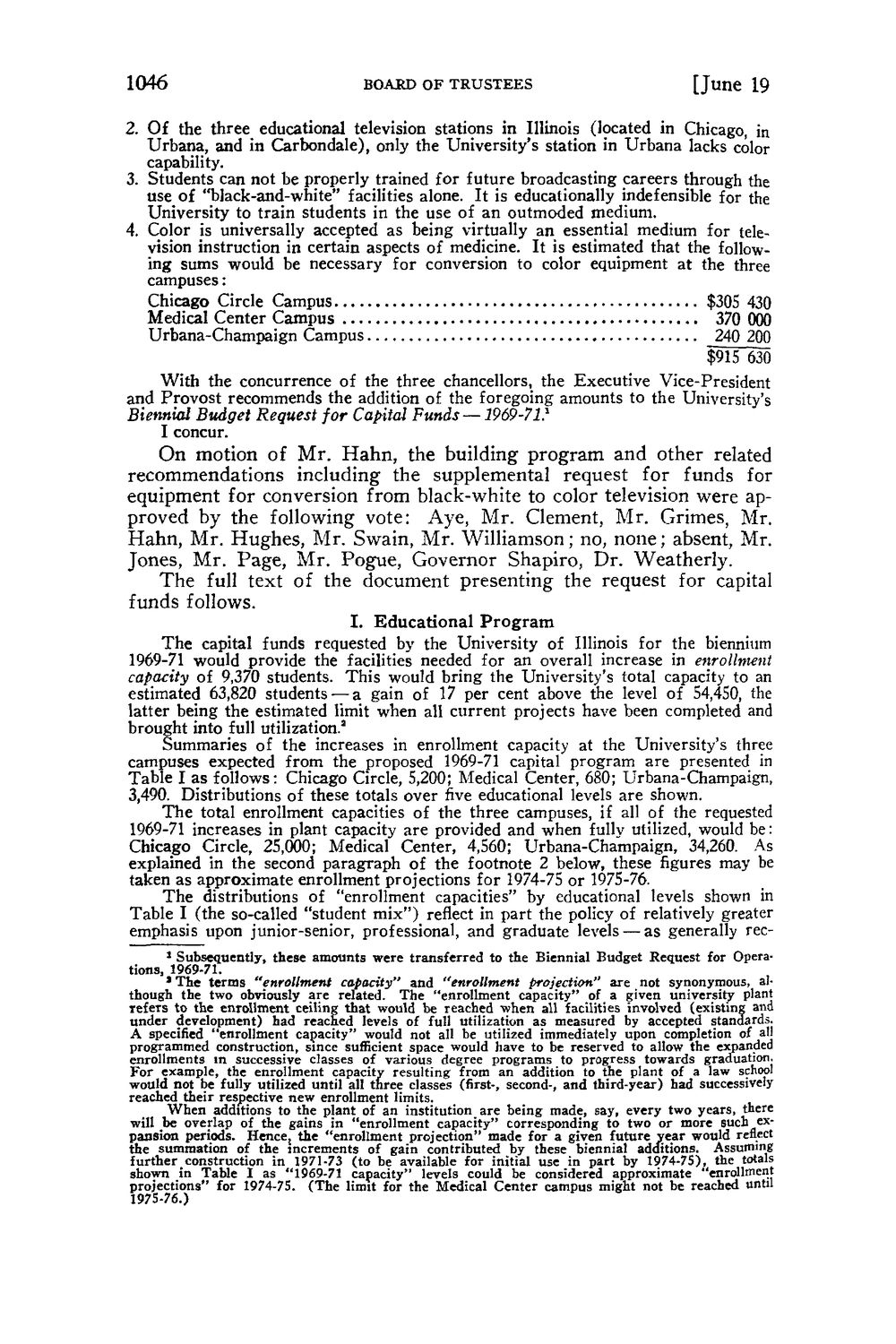| |
| |
Caption: Board of Trustees Minutes - 1968
This is a reduced-resolution page image for fast online browsing.

EXTRACTED TEXT FROM PAGE:
1046 BOARD O F TRUSTEES [June 19 2. Of the three educational television stations in Illinois (located in Chicago, in Urbana, and in Carbondale), only the University's station in Urbana lacks color capability. 3. Students can not be properly trained for future broadcasting careers through the use of "black-and-white" facilities alone. It is educationally indefensible for the University to train students in the use of an outmoded medium. 4. Color is universally accepted as being virtually an essential medium for television instruction in certain aspects of medicine. It is estimated that the following sums would be necessary for conversion to color equipment at the three campuses: Chicago Circle Campus $305 430 Medical Center Campus 370 000 Urbana-Champaign Campus 240 200 $915 630 With the concurrence of the three chancellors, the Executive Vice-President and Provost recommends the addition of the foregoing amounts to the University's Biennial Budget Request for Capital Funds —1969-71? I concur. On motion of M r . H a h n , the building program and other related recommendations including the supplemental request for funds for equipment for conversion from black-white to color television were approved by the following vote: Aye, Mr. Clement, Mr. Grimes, Mr. Hahn, Mr. H u g h e s , Mr. Swain, Mr. Williamson; no, n o n e ; absent, Mr. Jones, M r . Page, M r . Pogue, Governor Shapiro, Dr. Weatherly. T h e full text of the document presenting the request for capital funds follows. I. Educational Program The capital funds requested by the University of Illinois for the biennium 1969-71 would provide the facilities needed for an overall increase in enrollment capacity of 9,370 students. This would bring the University's total capacity to an estimated 63,820 students-—a gain of 17 per cent above the level of 54,450, the latter being the estimated limit when all current projects have been completed and brought into full utilization.' Summaries of the increases in enrollment capacity at the University's three campuses expected from the proposed 1969-71 capital program are presented in Table I as follows: Chicago Circle, 5,200; Medical Center, 680; Urbana-Champaign, 3,490. Distributions of these totals over five educational levels are shown. The total enrollment capacities of the three campuses, if all of the requested 1969-71 increases in plant capacity are provided and when fully utilized, would be: Chicago Circle, 25,000; Medical Center, 4,560; Urbana-Champaign, 34,260. As explained in the second paragraph of the footnote 2 below, these figures may be taken as approximate enrollment projections for 1974-75 or 1975-76. The distributions of "enrollment capacities" by educational levels shown in Table I (the so-called "student mix") reflect in part the policy of relatively greater emphasis upon junior-senior, professional, and graduate levels — as generally rec1 Subsequently, these amounts were transferred to the Biennial Budget Request for Operations, 1969-71. ' The terras "enrollment capacity" and "enrollment projection" are _ not synonymous, although the two obviously are related. The "enrollment capacity" of a given university plant refers to the enrollment ceiling that would be reached "when all facilities involved (existing and under development) had reached levels of full utilization as measured by accepted standards. A specified "enrollment capacity" would not all be utilized immediately upon completion of all programmed construction, since sufficient space would have to be reserved to allow the expanded enrollments in successive classes of various degree programs to progress towards graduation. For example, the enrollment capacity resulting from an addition to the plant of a law school would not be fully utilized until all three classes (first-, second-, and third-year) had successively reached their respective new enrollment limits. When additions to the plant of an institution are being made, say, every two years, there will be overlap of the gains in "enrollment capacity" corresponding to two or more such expansion periods. Hencej the "enrollment projection" made for a given future year would reflect the summation of the increments of gain contributed by these biennial additions. Assuming further construction in 1971-73 (to be available for initial use in part by 1974-75), the totals shown in Table I as "1969-71 capacity" levels could be considered approximate "enrollment projections" for 1974-75. (The limit for the Medical Center campus might not be reached until 1975-76.)
| |